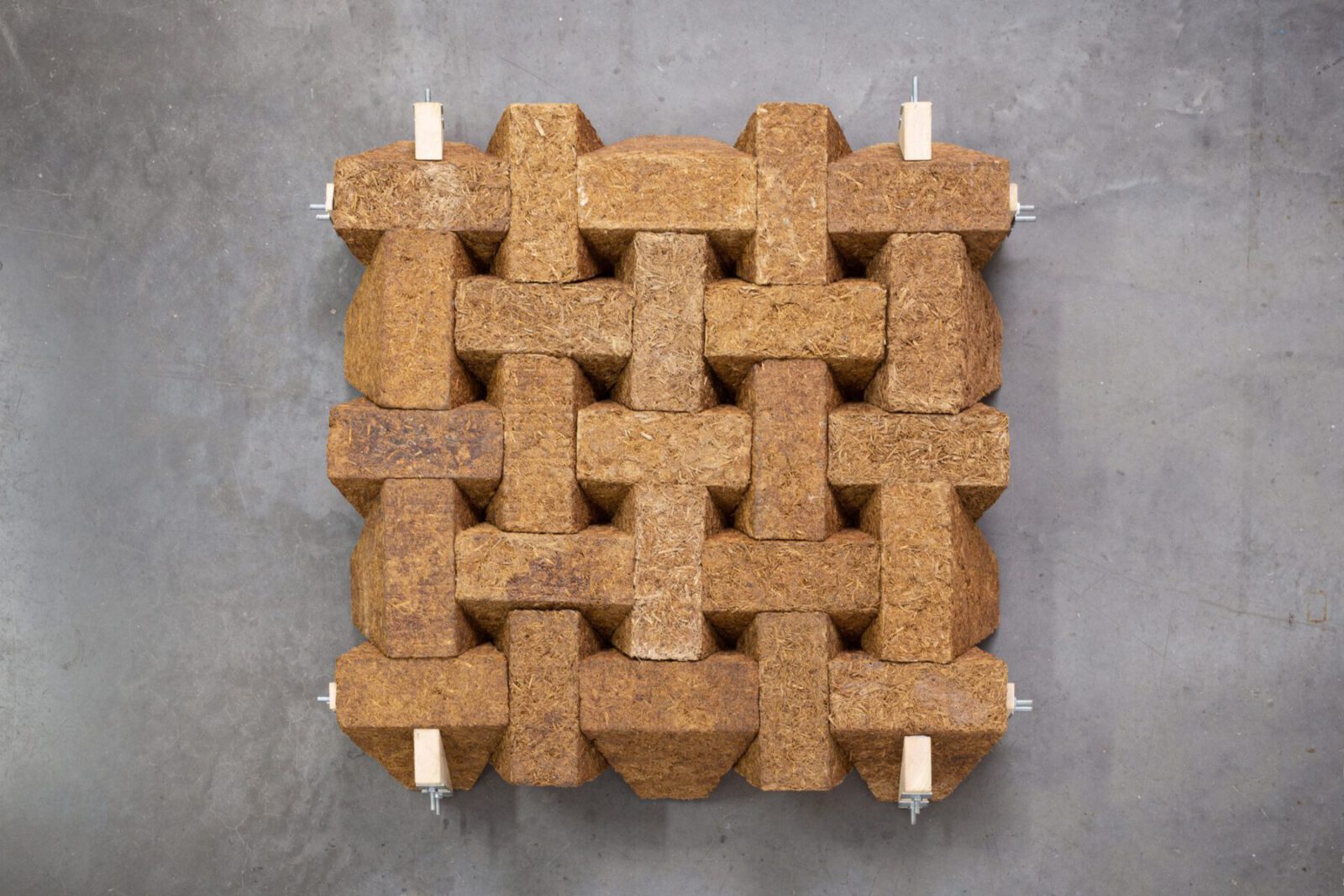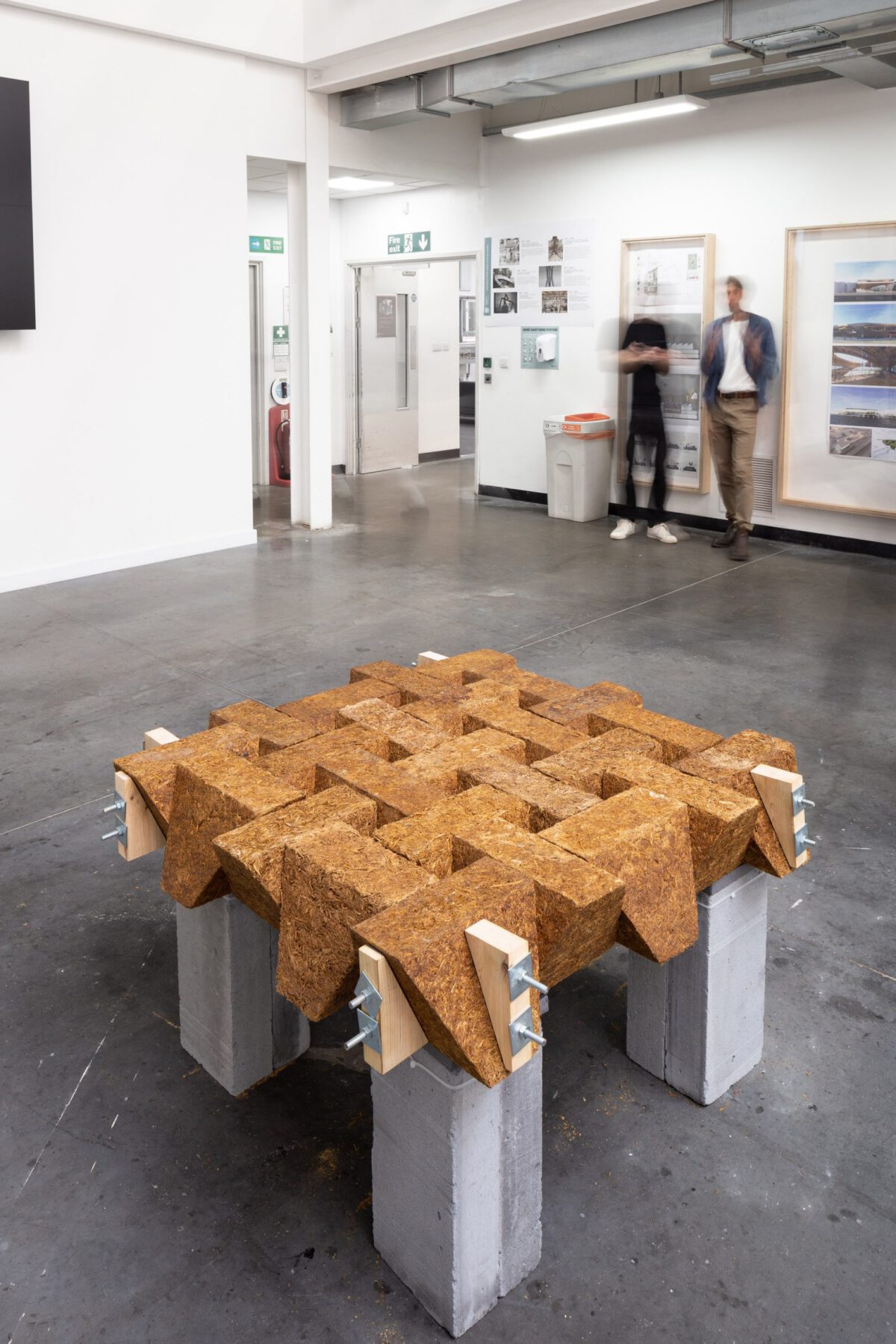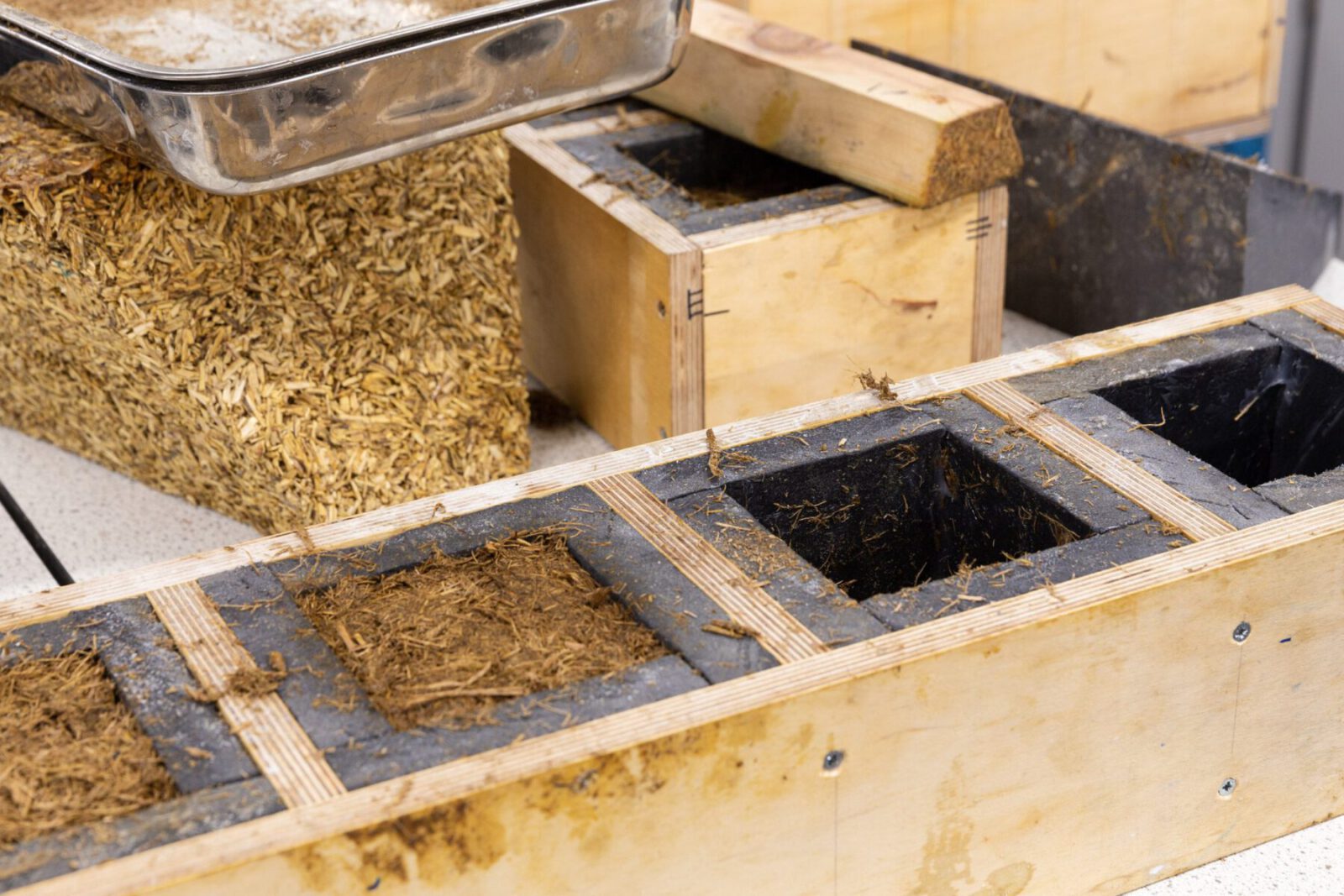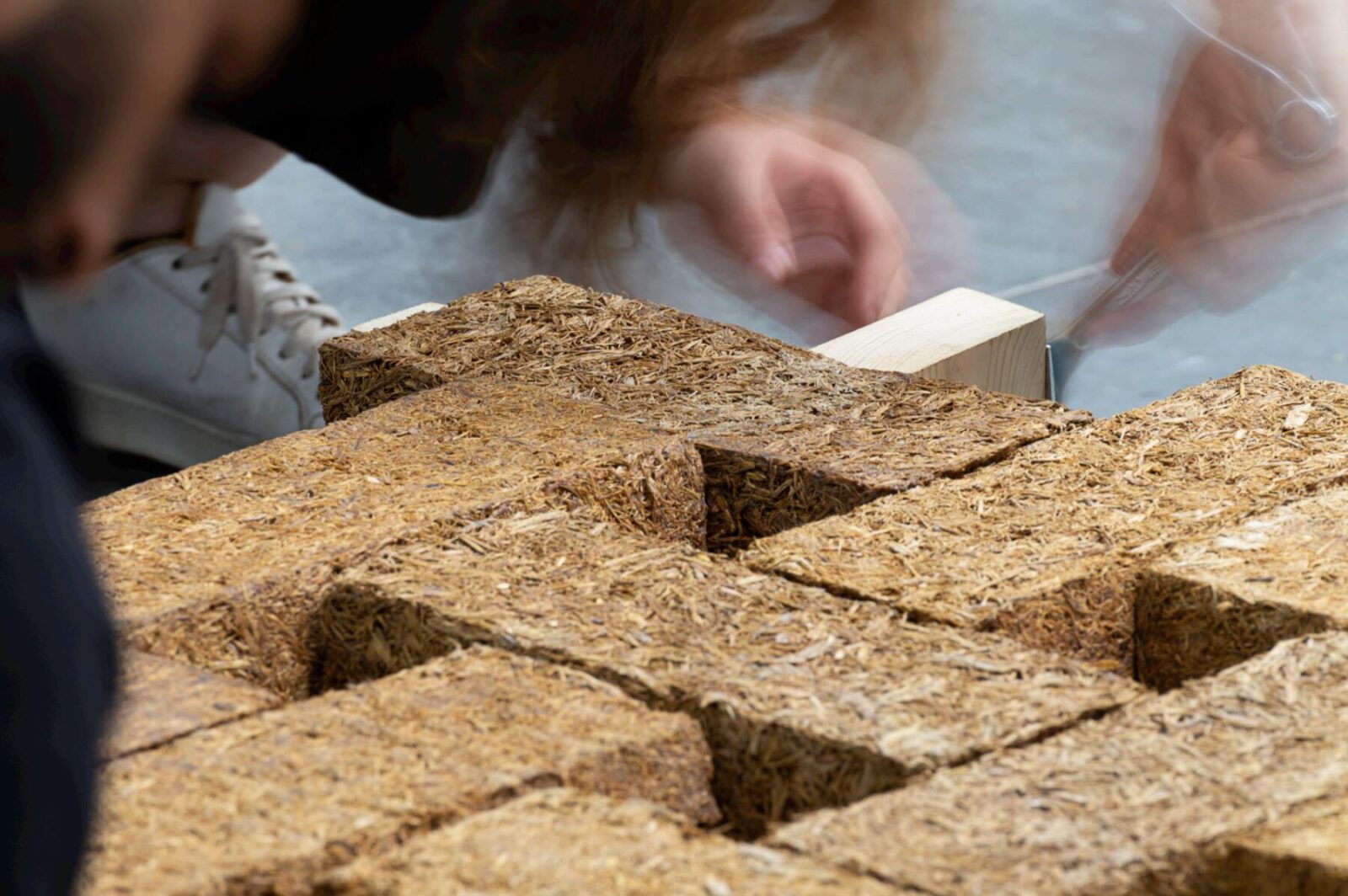Grimshaw and UEL develop Sugarcrete blocks that “could replace the traditional brick industry”. The University of East London reveals SugarcreteTM a low cost, low carbon construction material upcycling sugarcane by-products.
-press release
The University of East London’s (UEL) Master of Architecture and Sustainability Research Institute (SRI) with the support of Tate & Lyle Sugars has developed an innovative construction material – SugarcreteTM – which, using arable by-products, provides a sustainable, ultra-low carbon construction alternative to existing high carbon materials.
In creative partnership with Grimshaw the first technical application of SugarcreteTM – SugarcreteTM Slab has been prototyped.
Created by mixing the sugarcane fibres left over after sugar sap extraction, known as bagasse, with bespoke sand-mineral binders, SugarcreteTM is a material which has the potential to be used and re-used in new or existing structures, replacing both brick and concrete.
Developed over two years, testing of the material by UEL’s SRI showed that using SugarcreteTM, when compared to concrete production, reduces curing time to one week (a process that takes up to 28-days), is four to five times lighter than concrete block, only uses 15 – 20 per cent of its carbon footprint and provides substantially reduced costs.
Armor Gutierrez Rivas, Senior Lecturer in Architecture at UEL, said: “Sugarcane is the world’s largest crop by production volume – almost two billion tonnes of sugarcane are produced worldwide yearly, resulting in six hundred million tonnes of fibre bagasse as by-product. Using a bio-waste-based product like SugarcreteTM, we could replace the traditional brick industry, offering potential saving of 1,08 billion tonnes of CO2, 3 per cent of the global CO2 production. The built environment generates 40 per cent of annual global CO2 emissions. Despite the global aim to hold global warning to 1.5 degrees Celsius, it is estimated that our global built floor areas will double by 2060. Therefore, we must develop alternatives to current construction methods.”
As part of the research programme UEL developed a prototype floor-slab made from sugarcane derived from SugarcreteTM and used advanced digital modelling and robotic fabrication to test the viability of the ultra-low carbon materials in construction.
Grimshaw’s previous research into interlocking geometries – using the form of the building components to create self-supporting assemblies – allowed SugarcreteTM to be deployed as a demountable, reusable, fire resistant composite floor slab which can be applied, disassembled, or extended in new or existing structures.
“SugarcreteTM when integrated as a floor slab adapts Abeille’s 1699 design for dry assembly flat vaults – the system is made of interlocking components which transfer loads across the slab between blocks, restrained using post-tensioned perimeter ties, reducing the steel content of the slab up to 90 per cent.” said Elena Shilova, architect at Grimshaw. “Reducing steel, combined with the use of sugar cane fibres of different densities in a modular system allows the slab assembly to avoid the potential risks of cracking which occur with traditional concrete in extreme situations, absorbing the effects of seismic shock – a characteristic vital in earthquake prone regions where sugar cane is cultivated.”
As part of the project, and working with Tate & Lyle Sugars, the team has started to identify sites in the sugar producing Global South, which have the opportunity to adopt SugarcreteTM. The intention is to work with local NGO’s to test a prototype.
Alan Chandler, Co-Director of the UEL’s SRI, said: “By partnering locally, the production potential in each situation is evaluated, defining whether cement-use reduction can be made using locally created SugarcreteTM, or whether there is capacity to grow export markets for raw material or finished products to benefit GDP. This is particularly relevant for sugar producing communities where construction materials are frequently imported, environmentally poor performing, high cost and high carbon – for example a concrete block in Cuba, a major sugar producing country costs $3 – an average monthly salary is $148.”
SugarcreteTM has been nominated for this year’s Earthshot Prize by former winners, Notpla, in the Build a Waste-Free World category. In addition, researchers from UEL will publish their first set of SugarcreteTM journal papers with its partners over the coming year, alongside carrying out further research on structural, durability and acoustic properties of the constituent materials.
More information is available via the University of East London SugarcreteTM webpage.
Facts & Credits
Material Concept / Design and Fabrication Armor Gutierrez Rivas, Senior Lecturer in Architecture, UEL, Alan Chandler, Co-Director Sustainability Research Institute, UEL, Bamdad Ayati, Sustainability Research Institute Research Fellow, UEL, Elena Shilova, Architect, Grimshaw, Andy Watts, Director of Design Technology, Grimshaw
Collaborators John Kerr – Vice President, Research & Technology, Tate & Lyle Sugars, Paris Nikitidis – XR Developer, Grimshaw, Philip Singer – Computational Design Specialist, Grimshaw, Georgios Tsakiridis – Consultant, Grimshaw, Paolo Vimercati – Consultant, Grimshaw, Robert Sims – Model shop Manager, Grimshaw, Paul Nichols – FabLab Manager, UEL, Dr David Tann – Dean of School of Architecture, Computing & Engineering, UEL, Carl Callaghan – Head of Department of Architecture and Visual Arts, UEL, Alex Scott-Whilby – Architecture & Physical Design Cluster Lead, UEL, Nicolo Bencini – Senior Structural Engineer, AKTII, Sky Henley – Computational Design Specialist
UEL Master of Architecture Students Team Faith Omowunmi Ogundare; Busra Ciftci; Amy Gillespie; Hinal Arvindkumar Patel; Rova Taha; Dodangodagamage Kawan Roger Ranasinghe; Manoj Sai Ganji; Mohan Ukabhai Dungrani; Anca-Madalina Borda; Alina Klimenteva; Rashmi Madagamage Gunathilaka; Orseer Isreal Gbashah; Mahmoud Sayed Abdellattif; Mert Manas Erten; Hidayati Yazmin Binti Abdul Halim; Oluchukwu Judith Obiejesi; Svetoslav Georgie Slav; Mihriban Ustun
Photography Chromaphotography
Videography Jude Adoasi
Editing & filming Louis Bird and Ellie Saunders, Grimshaw
Link to SugarcreteTM video.
About Grimshaw
Grimshaw is an international architectural practice delivering buildings, infrastructure and places that are underpinned by the principles of humane, enduring, sustainable design. With offices in London, New York, Los Angeles, Paris, Dubai, Melbourne and Sydney, Grimshaw employs over 550 staff. The practice’s international portfolio covers all major sectors and has been honoured with over 200 international design awards.
Grimshaw Architects will be on ESO 2023.
Book your tickets here!
ESW Sponsors
Platinum Sponsor: ALUMIL
Gold Sponsor: ORAMA MINIMAL FRAMES
Silver Sponsor: ELVIAL
Bronze Sponsor: EUROPA
Distinctive Sponsor: ALUMINCO
Grand Sponsors: BENJAMIN MOORE, BLUM, FURNITURE GALLERY, GRUPPO CUCINE, LAFARGE, MARMYK, MARMOURIS, MOCKUP SPACES, NEOKEM, SATO, TSIALOS, URBI ET ORBI
Creative Sponsor: NAFPLIOTIS
READ ALSO: Cascading Terraces Residential Building | Χρυσό βραβείο A’ Design Award για την Potiropoulos+Partners





